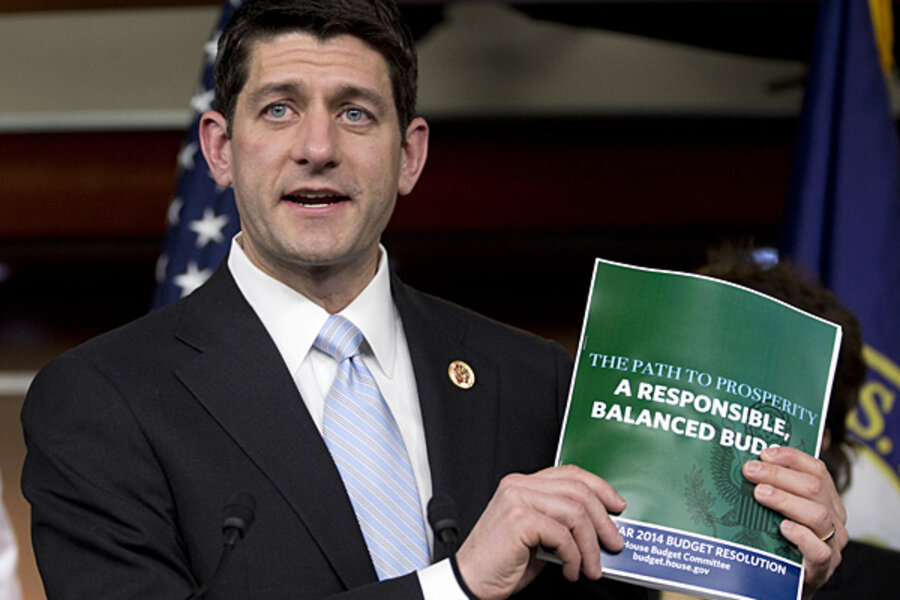In Paul Ryan budget, echoes of energy campaign rhetoric
Loading...
Rep. Paul Ryan (R) of Wisconsin has made a splash with his latest federal budget proposal, but in the energy portion of his plan, he has simply rehashed the themes that the Romney-Ryan ticket sounded during the 2012 presidential campaign:
- Approval of the Keystone XL pipeline;
- The opening up of more federal lands to oil and gas exploration;
- A reduction in federal loans to private energy companies.
That's not necessarily a bad thing – some of those ideas have bipartisan support. But the energy landscape has shifted since the 2012 election. Most notably, the hydraulic fracturing or "fracking" revolution has already put the US on course for virtual energy independence, making the Ryan plan seem dated. His plan also uses some questionable job estimates and was, apparently, so off-base in one area that a clean-energy chief executive has written the congressman to protest the claims.
"The Ryan budget is ideological blither-blather," said Joshua Freed, vice president for the clean energy program at Third Way, a think tank of centrist Democrats based in Washington. "There is an enormous opportunity for pragmatic regulatory reforms and policy action in energy," Mr. Freed added in a telephone interview. "But it requires a fresh look from both parties to accomplish."
The Ryan plan fails to address one of the leading questions for the energy industry – whether the US should export its newly found of liquefied natural gas (LNG). Also left unaddressed is the question of whether cheaper and cleaner natural gas should replace aging coal plants and serve as a "bridge fuel" to some clean-energy technology.
What Representative Ryan does address has significant support. For example: More than half the Senate, including nine Democrats, back the Keystone XL pipeline, which would carry oil from Canada to Texas refineries. A majority of the public seems to be on board as well – 63 percent, if a February 2013 poll by the American Petroleum Institute is accurate. The more neutral Pew Research Center found similar results a year earlier: a 66 percent approval rating.
In defending the Keystone XL pipeline, however, the Ryan plan uses some questionable numbers. It claims the project would create more than 20,000 direct jobs and 118,000 indirect jobs. Those numbers vary significantly from the State Department's latest assessment, which concluded the pipeline would result in 42,100 average annual jobs over a one- to two-year construction period, only 3,900 of which would be directly employed by the construction.
On a permanent basis, however, the operation of Keystone XL would generate only 35 jobs, according to the State Department.
Ryan's office did not respond to requests for comment.
The Ryan budget also criticizes Democrats' efforts to pass a cap-and-trade bill in 2009 that would have limited US carbon emissions and Obama administration investments in now-bankrupt clean-energy companies like Solyndra, A123 Systems, and Abound Solar. "The administration continues to penalize economically competitive sources of energy and to reward their uncompetitive alternatives," the budget reads.
But in detailing the failures of the Department of Energy's loan guarantee program, the Ryan budget also includes DOE-backed projects from SolarReserve and Mesquite Solar 1 among the "ill-fated ventures." By all appearances, those projects are either on schedule for completion or already in operation.
Construction of Mesquite Solar 1, a 150-megawatt solar plant in Arizona, was finished last December, according to Sempra U.S. Gas & Power, the company behind the project. It generates enough clean electricity to power about 56,000 homes, the company says, and the project created 528 local construction jobs at the peak of construction and 10 long-term positions.
The criticism of the other company – SolarReserve – so shocked its chief executive, Kevin Smith, that he wrote Ryan. SolarReserve's Nevada-based solar thermal plant is on schedule and on budget for completion by the end of 2013, according to a letter Mr. Smith sent to the congressman's office Tuesday.
"It’s a tremendous success story," he said in a telephone interview. "It’s incredibly inaccurate to call it 'ill-fated.'"
The administration's loan guarantees to private companies are controversial. Previous administrations – Republicans and Democrats – approved federal funding of cutting-edge research and development by companies at the precommercial phase. But they stopped short of supporting technology firms competing in the marketplace, as Obama has.
Ryan's plan aims to "restore competition to the energy sector with the goal of energy independence," the budget reads.
"Even if [these ventures] were successful and profitable, it wasn’t the loan gaurantee that made them profitable," said Nick Loris, an energy policy analyst for the conservative Heritage Foundation, via telephone. "It just means the taxpayers took on the risks that private investors should have [taken]."
"The public overwhelming supports drilling on public lands and the Keystone XL pipeline," he adds.
But by using questionable jobs numbers, failing to acknowledge the fracking revolution, and calling apparently successful commercial ventures "ill-fated," Ryan has dented the credibility of his plan, at least in the energy portion of his proposed budget.
"Someone," says Smith of SolarReserve, "didn't do their homework."








